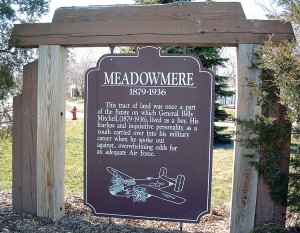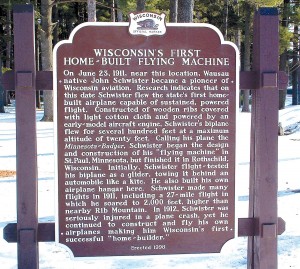By Rose Dorcey

Wisconsin Historical Markers highlight nearly 500 significant people, places and events from a community’s past. This marker tells about the boyhood home of General Billy Mitchell.
Off the beaten path, throughout Wisconsin’s farmlands and gently rolling hills, are 11 aviation-inspired historical markers. The Wisconsin Historical Markers “…identify, commemorate and honor the important people, places and events that have contributed to the state’s rich heritage” according to the Wisconsin Historical Society website.
Nearly 500 markers can be found in the state, with such varied titles as “Cranberry Culture,” “Auto Production in Kenosha,” “First Kindergarten,” “Colby Cheese,” “The Dinky” and “Birthplace of the Republican Party in Ripon.” Several commemorate war veterans and battles; many highlight the historic value of a community. Some are more playful, yet equally significant to a community’s history–such as “The Ice Cream Sundae” and “The Green Bay Packers.”
If you’re fortunate enough to be driving through the nearly unmatched beauty of Wisconsin’s Northwoods, you’ll find a marker titled “First Forest Fire Patrol Flight.” It explains how, in 1915, Jack Vilas became the first person to use an airplane for the purpose of forest fire patrols. It came about when a state forester traveled from Madison to northern Wisconsin for a summer vacation.
He saw the Vilas airplane parked on a lake, and asked to go for a ride. While aloft, they spotted a forest fire about 30 miles away, landed, and notified the authorities. The forester was so impressed by this that he rushed back to Madison to have Vilas appointed a fire warden. Vilas, a wealthy young man with hardly a care in the world, began daily forest fire patrol flights. For his work he requested the pay of “the thanks of the people”–he would have it no other way. The marker is located on Hwy. M, about six miles south of Boulder Junction.
Near the central Wisconsin city of Wausau, you’ll find what has to be an EAA’ers favorite marker, “Wisconsin’s First Homebuilt Flying Machine.” It’s located in Rothschild Park, in Rothschild, Wis. It’s a bit difficult to find, but worth reading. Here you will learn about the “Minnesota Badger” and the man who built it, John Schwister. Schwister began work on his self-designed airplane in Minnesota, but first flew it in Wisconsin, hence the name. The local Wausau newspaper documented his progress, in both building and learning to fly. He flew the airplane in the Wausau area from about 1911-12.
In Southern Wisconsin, near the Illinois border, is the city of Beloit. Beloit is the home of Wisconsin’s first aviator, Arthur Pratt Warner. A wealthy man, Warner became interested in aviation and traveled to New York to meet with a group of early aviators. He met Glenn Curtiss, and became so enthralled with flight that he immediately paid $6,000 for Curtiss to begin work on an airplane that was based on a June bug. When the airplane was complete, it was dismantled, crated and shipped by rail to Beloit. It was the first sale of an airplane to a private individual. Warner, mechanically inclined and eager to fly, completed the rebuild just weeks after receiving it. He flew the aeroplane for the first time on Nov. 4, 1909, bringing Wisconsin into the age of aviation.

John Schwister is credited with completing Wisconsin’s first homebuilt flying machine, in 1911. He coined it the “Minnesota-Badger,” after beginning construction in Minnesota and completing it in Wisconsin.
Stop at a historical marker and you’ll have the opportunity to learn more about General Billy Mitchell, where he grew up in Milwaukee County and the Wisconsin airport that’s named after him. You can learn about the birthplace of an airline in Clintonville, located on the grounds of Clintonville Municipal Airport (KCLI). There’s a tribute to Major Dick Bong, America’s Ace of Aces, in tiny Poplar. Nearby, in Superior, you can visit the Richard I. Bong WWII Heritage Center, which was created to honor all those who “fought and died, worked and waited during World War II”.
There are eight other Wisconsin Historical Markers with aviation themes. I won’t tell you the stories of them all; you’ll have to learn them on your visit.











